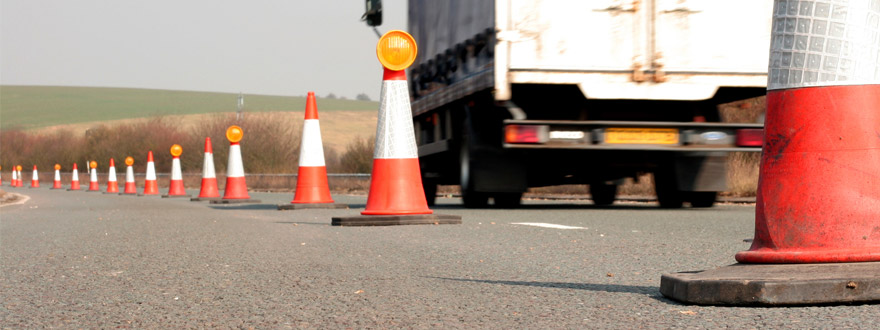What is a CSA score?

What is a CSA score?
Making the roads safer means holding motor carriers and drivers accountable for their role in preventing accidents. With that goal, the Federal Motor Carrier Administration (FMCSA) developed the Compliance, Safety and Accountability (CSA) system to improve—and enforce—safety among commercial motor vehicle (CMV) carriers.
Under this data-driven system, the FMCSA issues each carrier a CSA score based on its drivers’ individual performance and its fleet vehicles’ condition.
The FMCSA uses these CSA scores to:
- measure carrier and driver performance against clear, established safety standards
- identify high-risk carriers that may require an intervention
Safer fleets earn fewer violations and lower CSA scores, which is what you want if you’re a carrier. On the other hand, the more violations your drivers and vehicles earn, the higher your CSA score and the higher your risk of coming under closer scrutiny. You may even face an intervention and possibly incur an out-of-service order.
Note: Only carriers earn CSA scores, but those scores are based on their drivers’ performance. Drivers have a Pre-employment Screening Program report that tracks their violations and driving history. So, performing safely is important, even at the individual level.
What goes into your CSA score?
The FMCSA’s Safety Measurement System (SMS) uses data from roadside inspections and crash reports over the previous two years. Each month, this SMS data is updated and assigned to each carrier’s DOT number.
| Per the FMCSA’s CSA factsheet, the SMS considers: | |
|---|---|
| Number of safety violations and inspections | |
| Severity of safety violations or crashes | |
| When the safety violations occurred, with recent events weighted more heavily | |
| The number of trucks and/or buses a carrier operates | |
| Number of vehicle miles traveled | |
| Acute and Critical Violations found during investigations | |
Know your BASICs.
The FMCSA organizes this SMS data into the Behavior Analysis and Safety Improvement Categories (BASICs). Once the following data is collected and categorized, the SMS assigns carriers a percentile score from 0 to 100. Remember: the lower, the better.
Violations and crashes remain on the record for two years (24 months).
- Unsafe driving: Prioritizes interventions for repeated unsafe driving behaviors such as speeding, texting, reckless driving, improper lane changes and so on.
- Crash Indicator: Looks at history of state-reported CMV crashes that involve a fatality or injury, or requires the vehicle to be transported from the scene.
- Hours-of-service (HoS) compliance: Focuses on compliance with the U.S. and Canadian ELD mandates.
- Vehicle maintenance: Includes pre- and post-trip vehicle inspections, vehicle defects and improper repairs.
- Controlled Substances and Alcohol: Covers the misuse of alcohol, illegal drugs and medications that impair the driver’s ability to perform safely. Even having unopened alcoholic beverages in the cab is a violation.
- Hazardous Materials Compliance: Looks at compliance with how to properly package, mark, label, placard and load hazardous materials. Also looks at carrier’s understanding of regulations for tank specification testing, loading and unloading, attendance and leakage.
- Driver fitness: Examines driving records to ensure required files for each driver include commercial drivers’ licenses (CDLs), medical certificates, state driving records, annual records reviews and employment applications.
To keep your CSA score as low as you can, you need safe drivers behind the wheel of safe vehicles. Your score won’t suffer if you hire people who already have violations. But it may go up when they earn violations while operating as your fleet’s driver.
Set your fleet up for safety with the right mix of smart fleet management technology.
Outfit drivers to be as safe as possible.
Equip drivers with modern mobile tools.
Load reliable in-cab driver tablets with proven, trusted mobile applications to streamline daily tasks. Reduce drivers’ risk of falling behind schedule, rushing to the next destination or multitasking on their tablet while driving.
- Navigation
- ELD (HoS) compliance
- Electronically verified inspections
- Proactive driver coaching
- Two-way communication
- Third-party integrations and workflows
- Tire pressure monitoring system
Make ELD (HoS) compliance easier and more reliable.
The BASICs include ELD compliance because overworked, tired and impaired drivers pose a safety issue. Choose an ELD solution that makes complying with the HoS mandate easier.
- Meets title 49 CFR 395 Electronic Logging Devices and Hours-of-Service Certification
- Third-party certified with Transport Canada’s accreditation body, COMDriver, for use by Canadian fleets and federally regulated carriers crossing the U.S. and Canada border
- Supports various rulesets and exemptions for U.S. intrastate, interstate and passenger carrying fleets
To make compliance even easier, choose a solution that updates itself with the latest regulations, so your drivers are always tracking their hours to what’s current. And one that preemptively alerts drivers who are approaching violation.
Prevent accidents with real-time, in-cab driver coaching.
Safe driver performance is essential for a lower CSA score. But you can’t watch every driver, every moment to make sure they’re operating safely. Instead, look for a real-time driver coach solution with machine learning and an AI-powered dashcam that monitors the road ahead (and inside if you choose). And that issues audible warnings for critical unsafe behaviors.
Create a culture of safety using fleet gamification
Safer drivers incur fewer violations. Use that same driver coaching solution discussed above to launch a fleet gamification program. Level the playing field by tracking objective driver performance metrics.
- Create healthy competition using driver scorecards.
- Use objective data to open constructive conversations.
- Recognize (and help retain) your top performers.
- Coach those who have room to improve on specific behaviors.
- Engage every driver across your fleet to operate more safely.
Read our three-part series on fleet gamification to learn more.
Keep vehicles in safe working order.
Ensure inspections are done right every time.
Required pre- and post-trip inspections are part of the Vehicle Maintenance BASIC. A solution such as our electronic verified inspection reporting (EVIR®) system ensures accurate, verified inspections every time.
- Place a Zonar tag on each inspection zone of the vehicle.
- Drivers and operators must physically visit and scan each inspection zone.
- Inspection results are uploaded into our secure online portal.
- Create custom inspection configurations to fit your fleet vehicles and processes.
Integrate digital inspection results with maintenance workflow to streamline that process and ensure problems are addressed quickly—and reducing the likelihood of a violation.
Protect your vehicles with a complete, connected fleet health solution.
Finding and fixing issues is one line of defense against dangerous breakdowns and CSA violations. Setting up the right combination of fleet health solutions extends your ability to avoid violations for poor vehicle maintenance.
Look for fleet health solutions such as:
- Predictive maintenance for preventing breakdowns
- Diagnostics for identifying and addressing minor issues before they turn critical
Predict vehicle issues, prevent future problems.
Vehicle maintenance and repairs are factored into your CSA score. A single all make, all model predictive maintenance platform enables you to keep each vehicle in optimal mechanical condition—preventing breakdowns through proactive maintenance and repairs.
Reduce violations and tire-related breakdowns.
Per the FMCSA Analysis and Information (A&I), low and flat tires continue to be the leading out-of-service vehicle violation the industry faces today. More than 100,000 vehicles were placed out-of-service in 2023, nearly doubling the next nearest OOS violation (Brakes).
Avoid impacts to your CSA score and prevent tire-related downtime with a remote tire monitoring system. Monitor each tire across distances, even when the vehicle is moving. And enable drivers to use an in-cab app to see the real-time pressure and temperature before and during each trip.
Work with a smart fleet management provider that lives and breathes safety and compliance.
Safety isn’t to be taken lightly. Neither are poor CSA scores. Insurers look at those CSA scores, and high scores can raise insurance premiums. Most importantly, poor CSA scores indicate that your fleet has safety issues to overcome. And, chances are, some of those issues are downright dangerous.
Take a moment to check your CSA score.
See how much safer driving can save with our Safe Driving ROI calculator.
If you’re currently a Zonar customer, reach out to our safety and compliance experts.. They know your industry inside and out, and can help you put together an appropriate, effective program. One that can protect your CSA score. If you’re not already a Zonar customer, set up your complimentary consultation.





